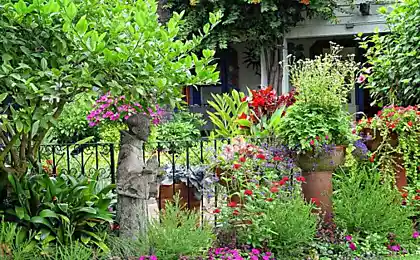1671
Redkotsvetuschie plants
While many plants bloom profusely every year and during all seasons, playing for time with other flowering. Some do not bloom for years and even centuries, making bloom in an event that happens once in a lifetime.
10. A plant that eats sheep

This plant is named so for good reason - it really is a killer of animals! It throws monstrous, three-meter flowers in the shape clubs that attract the sheep and other animals. Animals, hitting the spikes will eventually die of starvation or omissions. Some believe that the plant is eaten by sheep (known as the Puya chilensis) to develop this skill, to rotting corpses and obtain nutrients.
And if you think that this plant will be a great way to protect your lawn from dogs, you should reconsider its decision, as it slowly grows and blooms once every 15-20 years.
9. Madagascar Palma

Madagascar Palm (Tahina spectabilis) grows to enormous size, dies after fruiting, and blooms only once - after the 100th anniversary. What makes this particularly unique tree was found in 2008 alone. Prior to that, probably due to the fact that palm bloomed very rare, no one noticed that the tree is different from other trees. The tree has a surprisingly similar characteristics with palm trees, found in Asia (approx. 6000 km), which has led some scientists to believe that there were palm trees in Madagascar since the island was separated from India 80 million years ago.
Despite the fact that thousands of seeds were collected after the discovery of a tree, and a handful of them was sent to the botanical gardens, nature remains less than 100 Madagascan palm trees.
8. Queen of the Night
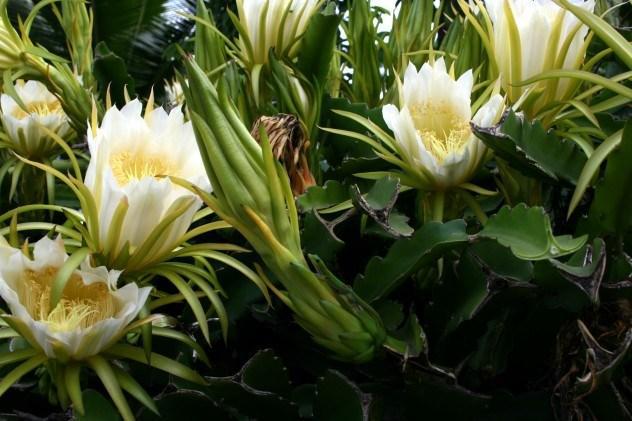
Compared with other plants in this list, the queen of the night (Selenicereus grandiflorus-Selenicereus grandiflorus) almost a year rastsvetaet- quickly. Nevertheless, even catch a glimpse of the cactus flower is difficult because it mainly grows in the deserts of Sonora and Chihuahua and blooms only at night.
Despite its attractive white and yellow flowers, cactus few scares her long, tentacular stems, which cling to whatever is nearby, and given that the plant can grow up to 12 meters in length, it is clear that you can catch on for more.
7. campion angustifolia

Silene angustifolia (Silene stenophylla) is something like, white crow on this list, because it usually blooms every summer. However, there was one particular Silene angustifolia, which took more than 30 000 years before bloom, so, of course, this flower can be classified as redkotsvetuschy.
So, because of what was the delay? As it turned out, the plant in the form of seeds stuck in the Siberian permafrost since the time of the Ice Age. Biologists have found it in fossilized squirrel burrow and after radiocarbon study showing its age 31,800 years, rose and began to grow. Ice Age plant looks remarkably similar to the modern look campion, with only minor differences in the seeds, roots and buds.
Scientists have discovered hundreds of thousands of well-preserved seeds and nuts in a hole, and would like to see what other prehistoric treasures show up in thawing ground. However, the hype surrounding the results of several bedrooms, as melting permafrost is a constant reminder of climate change.
6. The plant Kurindzhi

When flowering bush Kurindzhi purple and blue flowers cover the whole plant. It adorns the slopes of the Western Ghats in South India, and this species is so impressive that the Nilgiri mountain range (which translates as "Blue Mountain") was named in honor of this phenomenon. Unfortunately, Kurindzhi sparingly at profuse flowering bushes and blooms only once in 12 years. However, the cycle of flowering shrub that is very clear, they say that the indigenous tribes Palia used the plant to keep track of your age.
Unfortunately, Kurindzhi is under threat due to the development of the construction, although environmental groups working to protect this unique plant.
5. Agave americana
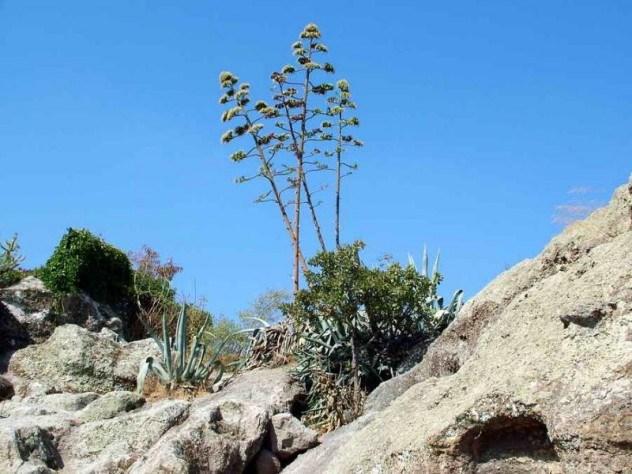
Although it is sometimes called a "plant the century" - the cycle of flowering American Agave is 10 years. It is a common ornamental plant that is grown all over the world, and it is likely that you have seen it growing in the garden or in someone's yard. In fact, you may have confused it with the aloe plant, because when not flowering agave, these two plants look very similar. However, when the agave blossom, nothing like you've ever seen (except maybe in a book by Dr. Seuss), as it throws up to eight meters tall stalk with branches at the edges of which are collected in clusters of yellow flowers. < br />
In addition to the type of cool, Agave americana is also grown for food, antiseptics and juice.
4. The Queen of the Andes

Queen of the Andes (Puya raimondii) always hampers the growth of other vegetation of the Andes, but when she finally bloom (through 80-150 years), it grows up to 12 meters in height and really looks like a super plant. Surprisingly, it grows so far in regions with harsh climates and at high altitudes, it seems impossible for any other flowering plants.
During flowering, the Queen of the Andes, throws up a spike with seeds, which grow thousands of white, green and purple. After the spike resets millions of seeds, the plant dies.
Due to grazing, burning and other factors reduced the population of this plant throughout Peru and Bolivia.
3. Melocanna Baciffera
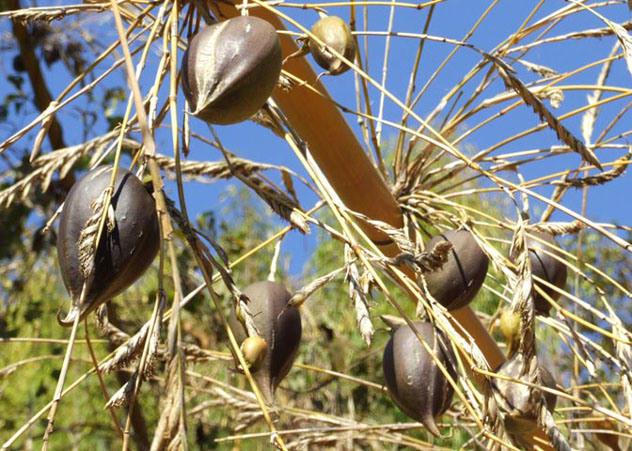
Melocanna baciffera is a species of bamboo, which makes up most of bamboo in India. It blooms every 44 - 48 years, and, of course, the locals would like to interval was longer. Why are they afraid of flowering and appearance of seeds? Well, attached to these flowers are large fruits contain copious amounts of seeds that attract rodents. So what should be a magnificent spectacle of nature is transformed into the invasion of black rats. It is so serious that the Indians have even invented a name for this event -Mautam (death of bamboo).
Apart from the fact that rats carry diseases, they create another serious problem -golod. This is due to the fact that destroying the seeds of bamboo rats also destroy stocks of human granaries.
2. Tallipotovaya palm
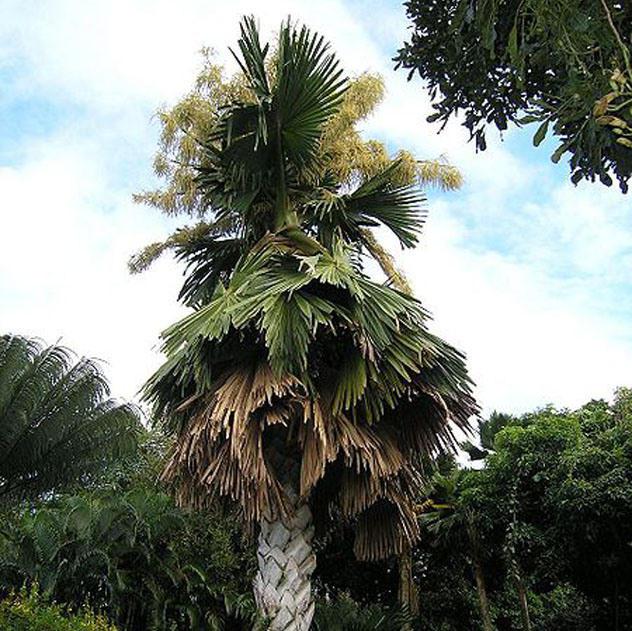
Tallipotovaya palm is another giant plant, as compared to other palm that grows up to 25 meters tall and has a trunk diameter of one meter. Furthermore, inflorescence is branched it six to eight feet in height - is greater than any of the plants. Excessive patience necessary to see this tree in bloom, as it blooms only once between the ages of 30 to 80 years. However, it is somewhat bitter, seeing flowering, because it means that life is coming to an end palms. Palma spends all his energy for the production of fruit the size of a golf ball that is falling rain down hundreds of thousands of palm trees before his death.
Tallipotovaya palm tree is the national tree of Sri Lanka and it is grown for various commodities, including wood, straw and buttons (made from seeds).
1. Giant Himalayan Lily

Himalayas in general seems to have magical qualities, and a giant Himalayan lily (Cardiocrinum giganteum) living there is no exception. Most of his life, it grows as a modest cluster of glossy leaves, but after five to seven years, the plant mysteriously grows to three meters and produces a gift thin, funnel-shaped flowers.
It is the largest of all types of lilies and naturally grows on the hills of northern India to Japan. However, the researchers found a flower in the middle of the 1800s, and since then, patient gardeners have succeeded in growing the plants under different climatic conditions.
10. A plant that eats sheep

This plant is named so for good reason - it really is a killer of animals! It throws monstrous, three-meter flowers in the shape clubs that attract the sheep and other animals. Animals, hitting the spikes will eventually die of starvation or omissions. Some believe that the plant is eaten by sheep (known as the Puya chilensis) to develop this skill, to rotting corpses and obtain nutrients.
And if you think that this plant will be a great way to protect your lawn from dogs, you should reconsider its decision, as it slowly grows and blooms once every 15-20 years.
9. Madagascar Palma

Madagascar Palm (Tahina spectabilis) grows to enormous size, dies after fruiting, and blooms only once - after the 100th anniversary. What makes this particularly unique tree was found in 2008 alone. Prior to that, probably due to the fact that palm bloomed very rare, no one noticed that the tree is different from other trees. The tree has a surprisingly similar characteristics with palm trees, found in Asia (approx. 6000 km), which has led some scientists to believe that there were palm trees in Madagascar since the island was separated from India 80 million years ago.
Despite the fact that thousands of seeds were collected after the discovery of a tree, and a handful of them was sent to the botanical gardens, nature remains less than 100 Madagascan palm trees.
8. Queen of the Night

Compared with other plants in this list, the queen of the night (Selenicereus grandiflorus-Selenicereus grandiflorus) almost a year rastsvetaet- quickly. Nevertheless, even catch a glimpse of the cactus flower is difficult because it mainly grows in the deserts of Sonora and Chihuahua and blooms only at night.
Despite its attractive white and yellow flowers, cactus few scares her long, tentacular stems, which cling to whatever is nearby, and given that the plant can grow up to 12 meters in length, it is clear that you can catch on for more.
7. campion angustifolia

Silene angustifolia (Silene stenophylla) is something like, white crow on this list, because it usually blooms every summer. However, there was one particular Silene angustifolia, which took more than 30 000 years before bloom, so, of course, this flower can be classified as redkotsvetuschy.
So, because of what was the delay? As it turned out, the plant in the form of seeds stuck in the Siberian permafrost since the time of the Ice Age. Biologists have found it in fossilized squirrel burrow and after radiocarbon study showing its age 31,800 years, rose and began to grow. Ice Age plant looks remarkably similar to the modern look campion, with only minor differences in the seeds, roots and buds.
Scientists have discovered hundreds of thousands of well-preserved seeds and nuts in a hole, and would like to see what other prehistoric treasures show up in thawing ground. However, the hype surrounding the results of several bedrooms, as melting permafrost is a constant reminder of climate change.
6. The plant Kurindzhi

When flowering bush Kurindzhi purple and blue flowers cover the whole plant. It adorns the slopes of the Western Ghats in South India, and this species is so impressive that the Nilgiri mountain range (which translates as "Blue Mountain") was named in honor of this phenomenon. Unfortunately, Kurindzhi sparingly at profuse flowering bushes and blooms only once in 12 years. However, the cycle of flowering shrub that is very clear, they say that the indigenous tribes Palia used the plant to keep track of your age.
Unfortunately, Kurindzhi is under threat due to the development of the construction, although environmental groups working to protect this unique plant.
5. Agave americana

Although it is sometimes called a "plant the century" - the cycle of flowering American Agave is 10 years. It is a common ornamental plant that is grown all over the world, and it is likely that you have seen it growing in the garden or in someone's yard. In fact, you may have confused it with the aloe plant, because when not flowering agave, these two plants look very similar. However, when the agave blossom, nothing like you've ever seen (except maybe in a book by Dr. Seuss), as it throws up to eight meters tall stalk with branches at the edges of which are collected in clusters of yellow flowers. < br />
In addition to the type of cool, Agave americana is also grown for food, antiseptics and juice.
4. The Queen of the Andes

Queen of the Andes (Puya raimondii) always hampers the growth of other vegetation of the Andes, but when she finally bloom (through 80-150 years), it grows up to 12 meters in height and really looks like a super plant. Surprisingly, it grows so far in regions with harsh climates and at high altitudes, it seems impossible for any other flowering plants.
During flowering, the Queen of the Andes, throws up a spike with seeds, which grow thousands of white, green and purple. After the spike resets millions of seeds, the plant dies.
Due to grazing, burning and other factors reduced the population of this plant throughout Peru and Bolivia.
3. Melocanna Baciffera

Melocanna baciffera is a species of bamboo, which makes up most of bamboo in India. It blooms every 44 - 48 years, and, of course, the locals would like to interval was longer. Why are they afraid of flowering and appearance of seeds? Well, attached to these flowers are large fruits contain copious amounts of seeds that attract rodents. So what should be a magnificent spectacle of nature is transformed into the invasion of black rats. It is so serious that the Indians have even invented a name for this event -Mautam (death of bamboo).
Apart from the fact that rats carry diseases, they create another serious problem -golod. This is due to the fact that destroying the seeds of bamboo rats also destroy stocks of human granaries.
2. Tallipotovaya palm

Tallipotovaya palm is another giant plant, as compared to other palm that grows up to 25 meters tall and has a trunk diameter of one meter. Furthermore, inflorescence is branched it six to eight feet in height - is greater than any of the plants. Excessive patience necessary to see this tree in bloom, as it blooms only once between the ages of 30 to 80 years. However, it is somewhat bitter, seeing flowering, because it means that life is coming to an end palms. Palma spends all his energy for the production of fruit the size of a golf ball that is falling rain down hundreds of thousands of palm trees before his death.
Tallipotovaya palm tree is the national tree of Sri Lanka and it is grown for various commodities, including wood, straw and buttons (made from seeds).
1. Giant Himalayan Lily

Himalayas in general seems to have magical qualities, and a giant Himalayan lily (Cardiocrinum giganteum) living there is no exception. Most of his life, it grows as a modest cluster of glossy leaves, but after five to seven years, the plant mysteriously grows to three meters and produces a gift thin, funnel-shaped flowers.
It is the largest of all types of lilies and naturally grows on the hills of northern India to Japan. However, the researchers found a flower in the middle of the 1800s, and since then, patient gardeners have succeeded in growing the plants under different climatic conditions.



















